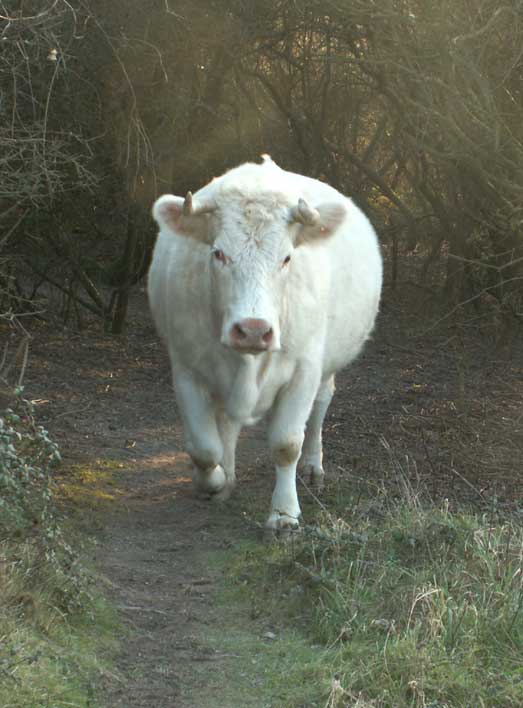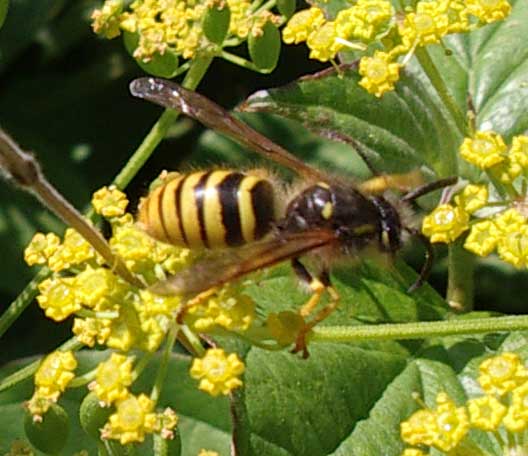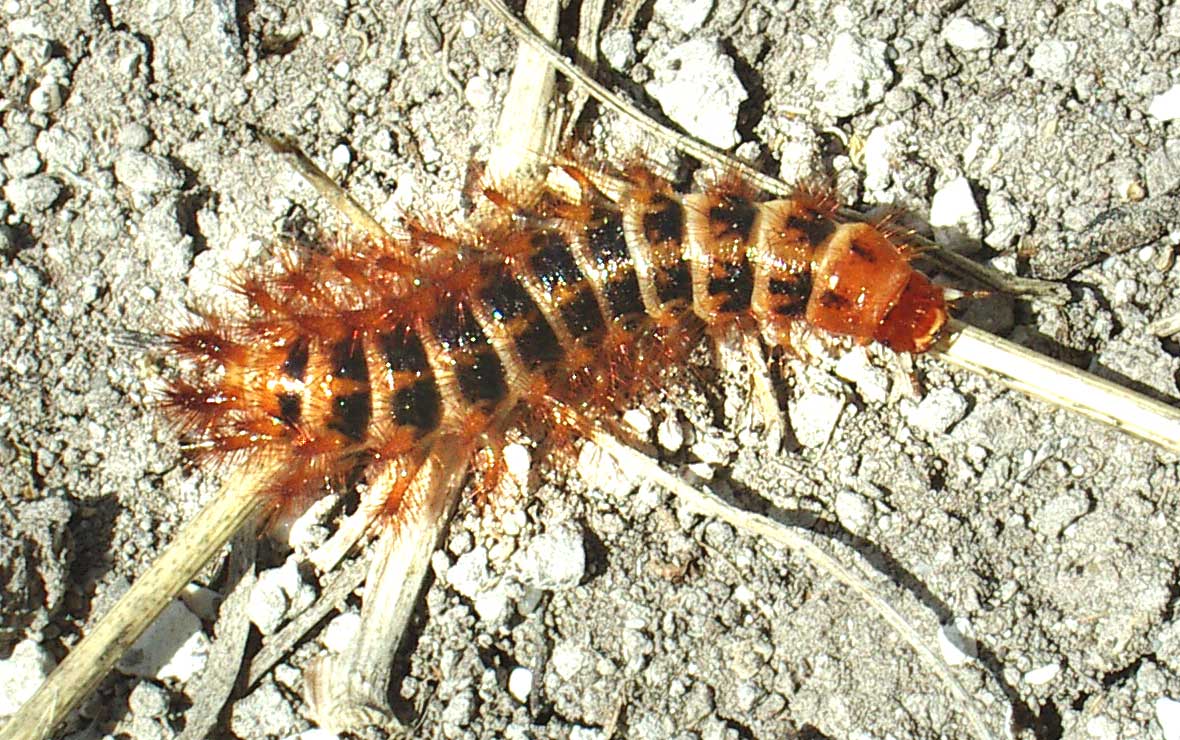
Musk Thistle (right)

4 July
2007
On
another breezy (Force
6) overcast day when butterflies
were generally not flying, a few Meadow
Brown
Butterflies,
a Gatekeeper
and
a Small Tortoiseshell
and a Comma
were seen in the scrub of the north-west of Mill
Hill. Field Scabious
was noted in flower. A Common Lizard
was seen under a piece of roofing felt deliberately laid down in the central
mixed scrub and grass area near the northern perimeter. Its middle was
plump, presumably with its viviparous young.
Full
Butterfly Report
 |
A
solitary wasp in the genus Ectemnius
was seen in the north-west part of Mill Hill.
Musk Thistle (right) |
 |
12
April 2007
Ground
Ivy was seen amongst the scrub in the
north-west part of Mill Hill. However,
in many places the new growths and older growths of Dogwood
were obscuring everything.
28
March 2007
Ground
Ivy was seen with the Sweet
Violets in the scrub in the north-west
part of Mill Hill. There were no bee-flies
to be seen. A Peacock Butterfly flew
over.
21
March 2007
Basking
on Footpath 3138
(as it winds its way through Mill Hill
amongst the first bit of Hawthorn scrub to the north of the lower slopes)
I clearly saw my first Small Tortoiseshell
Butterfly of the year. It was an orange
variety which I think are local broods. It was closed at first and then
opened one wing and flew off quickly. I saw and heard a pair of Long-tailed
Tits aongst the Hawthorn in this area.
Adur
Butterfly List 2007
Adur
Butterflies: First Dates
15
June 2006
The
bumblebee
mimic hoverfly Volucella
bombylans var. bombylans with
an orange tail was seen along the path that is becoming overgrown with
Dogwood
in parts in the north-west part of Mill HillNature
Reserve. There was a large patch of
Ground
Ivy with
Germander
Speedwell. Both plants have small flowers
in the purple-blue colour.
| 26
April 2006
The favoured nectaring plant of the Dotted Bee-fly below is the Ground Ivy which was commonly in flower on the edge of the path. There
were clumps of Sweet Violets
still in flower as well.
|
 |
| 6
April 2006
A solitary Bee-fly (with spotted wings), Bombylius was seen on a path through the scrub in the north-west of Mill Hill. This
is Bombylius
discolor,
a declining BAP (Biodiversity Action
Plan) species.
At least one cow pat was still on the path but now it was dried out. |
 |
10
February 2006
The
temporary metal barrier has been reinstated and the cattle
cannot get on to Mill Hill by the stile (in the north-west). The
cow pats were still there on the paths. They were still moist and they
were a thorough nuisance (as was dog's mess as well).
1 February
2006
The
cattle
have been removed from the "lambing field" or intermittent pasture to the
south-east of Old Erringham Farm and will not now venture on to Mill
Hill. This is probably because the grass on the land has now been grazed
to its optimum and is best left for the spring growth. This pasture is
of no butterfly value although the fringes
may contain the occasional wild flower.
January
Cattle Report
30
January 2006
There
are cattle
all over Mill Hill from Old Erringham Farm
enriching the low nutrient hillsides with their dung and threatening the
flora (Horseshoe
Vetch) and the internationally important
population of Chalkhill Blue Butterflies.
It looks like the fence was broken down deliberately, probably at the instigation
of the South Downs Conservation Board
on public land given to the people of Shoreham. There is also the danger
or erosion, breaking up the steps under the hooves of the cattle and reduction
of the amenity value of the downs. They were timid cattle and they were
shooed of the vulnerable lower slopes
by the public. Most of the dung was on the
steps near the stile in the north-west corner of Mill
Hill Nature Reserve.
17 October 2005
Common
Wasps were frequent around the Ivy (near
the stile in the north-west corner) much more than in the previous years
this century.
27
September 2005
The
Fresh Breeze Force 4 (at 24 mph bordering on
Force 5) from the south-west (224° azimuth)
felt stronger and more from due south. This
wind may or may not have brought immigrant Red
Admirals to Shoreham. To my surprise at
least nine more on a single clump of Ivy near (just south of) the stile
in the far north-west corner of Mill Hill
Nature Reserve. There were also two Meadow
Browns and two Speckled
Woods around the same Ivy.
4 September
2005
There
was Honey Fungus Mushrooms
( a pest species of trees) on the Hawthorn
scrub immediately to the north of the lower
slopes of Mill Hill. In
the same Hawthorn scrub, at least
two Speckled Woods
fluttered over the path before I returned via the ridge (so I was only
the scrub for about three minutes).
 |
 |
These
insects were discovered in the Hawthorn wood/scrub in the north-west of
Mill
Hill. The first wasp was quite small.
The
social
wasp (Vespidae) is a worker Dolichovespula
sylvestris, a common social species
which is often found at this time of year.
The multiple-legged insect, a larva (not a centipede), was crawling towards the right of the photograph. It seems to have eleven segments. It was crawling over the path between the northern end of the lower slopes and the stile. It may be a beetle larva. It estimated length is 25 mm. This may be the larva of Drilus flavescens, which is frequent on the downs in southern coastal areas.
I think this must be a Drilus larva. It looks just like the diagram in Westwood's book. (Richard Jones)
2 August
2005
It
was in this area that the spectacular (by fly standards) hoverfly
Volucella zonaria was seen. By the
stile there were at least ten Chalkhill
Blue Butterflies and a Peacock
Butterfly over the other side of the barbed
wire on Erringham Hill.
1 May
2005
In
a recently cleared area in the north-west of Mill Hill,
two
male Orange Tip Butterflies
fluttered by, only pausing to nectar on the common Ground
Ivy for less than a second. The white butterflies
were two Small Whites.
27
April 2005
A
Peacock
Butterfly displayed in a cleared part
of the scrub, with planty of blow-flies including the Grey
Flesh Fly Sarcophaga, and the undistinguished
fly Tilius elongatus.
22
November 2004
In
the scrubby area of Hawthorn
in the north-west of Mill Hill Nature Reserve,
a small yellowish mushroom
was spotted in the area cleared by the South Downs Conservation Board.
 |
 |
As this species was growing out of the soil it is thought to be Mycena flavescens. There is a similar species Mycena arcangeliana which grows on wood.
Welted Thistle was still in flower.25
October 2004
The
normal long journey through the scrub involves a trek down the path through
the lower slopes to the stile, and then the climb following the path to
the northern edge (turn left at every junction) until the path veers around
to heading east parallel with the arable field which is Erringham Hill.
Then at the first path on this uphill (lesser gradient than before) bit
that branches south through the glades of long grass due south into the
area I have christened the Triangle. I then
turn east and veer north to regain the path and enter the copse (proper
small wood with Corsican Pines and Italian Alder at the top of Mill Hill)
and follow the tarmacked trail around until it opens up to a long grass
meadow north of the upper car park.
 |
 |
|
The
wooden steps are appreciated as it would have been too muddy and slippery
to climb the path without this terracing. There was nothing of note except
that the thistleabove
looked slightly different from the normal species.
Adur
Thistles
14
October 2004
I
did not venture into the Hawthorn
scrub/woodland, but just traipsed the short distance from the lower slopes
to the stile and back again, noticing that a White
Campion was still in flower by the path.
 |
 |
 |
 |
In the a cleared area of scrub in the north-west of Mill Hill Nature Reserve, there were a few small mushrooms on a stump. They were only small, at most 25 across their sticky caps.
There
was also my first record of a distinctive
snail, a tower-like mollusc, on Mill
Hill. These snails were expected but I had not seen them before on
Mill Hill proper. This tower-like snail is probably Cochlicella
acuta. This is reported as a coastal
species only.
More
Information on the Snail
Fungi
of Shoreham
24
September 2004
The
following plants were noted adjoining the path as it winds its way through
the Hawthorn wood:
 |
 |
 |
Other
plants noteworthy were a few patches of Hound's-tongue,
Cynoglossum
officinale, (not illustrated) not in flower, and present in the
cleared patches with lots of other early colonisers.

2
September 2004
I
surprised a male Emperor Dragonfly
in the scrub in the north-west which too flight rapidly.
Adur
Dragonflies
22
August 2004
A
female
Emperor Dragonfly cruising just above head height was the highlight,
but there was a Wall Butterfly
and at least a full dozen Speckled Wood
Butterflies.
 21
June 2004
21
June 2004
Garlic
Mustard has been identified by the steps
in the north-west corner near the stile leading the footpath through Old
Erringham Farm. At least the plant in the photograph has been identified
as such, but there is some doubt. At least half a dozen Speckled
Wood Butterflies were seen in the shady
scrub.
13
June 2004
Nectaring
in the Old Erringham grazing land to the north of Mill Hill, there were
several male Common Blue Butterflies and
this usually barren pature had Common Milkworts,
Bird's
Foot Trefoil,
Eyebrights
and Hawkweeds in
flower. In the Hawthorn copse that dominates the northwest corner of Mill
Hill Nature Reserve, a half a dozen Speckled
Wood Butterflies fluttered and then settled.
There was just a single Red Admiral Butterfly.
10
May 2004
In
the scrub in the north-west of Mill Hill Nature
Reserve there were a handful of Brimstone
Butterflies and at least one Speckled
Wood Butterfly.
26
April 2004
In
the scrub in the north-west of Mill Hill
there were two Speckled Wood Butterflies
and a single Peacock Butterfly.
15
April 2004
A
Peacock
Butterfly settled on some bare earth amongst
the Hawthorn scrub. The following plants were in flower amongst
the undergrowth:
 |
 |
 |
|
|
|
|
 |
 |
|
These violetsgrow higher up to a height of 130 mm. |
These violets grow higher, up to a height of 130 mm |
Lower
Slopes 2004
Violets
of Mill Hill
Triangle
2004
Upper
Slopes
Middle
Slopes
Planted
Copse
Plan
of Mill Hill